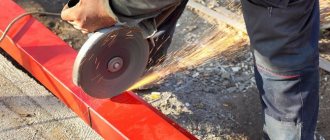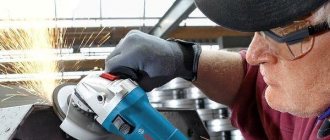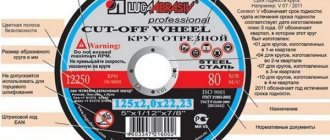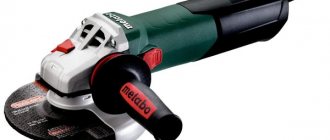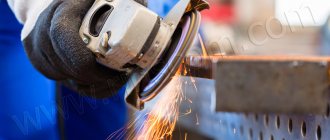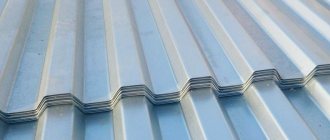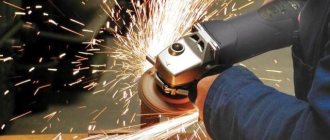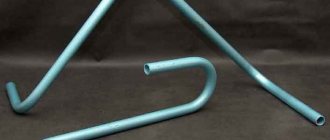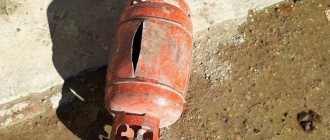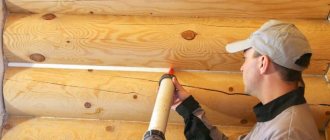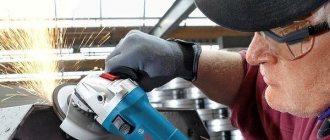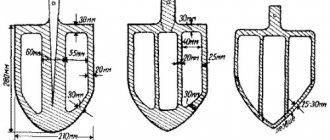Metal is the material that the angle grinder (angle grinder) was originally designed to work with. Now it is used to cut reinforcing bars, various metal sheets, pipes of various diameters, brick, concrete, stone, tiles and other building materials. Thanks to the presence of a variety of attachments, the grinder also allows you to polish and grind the surfaces of products. Cutting metal with a grinder is one of the main, most common jobs. To reduce the likelihood of injury, it must be performed correctly, with strict adherence to general and personal safety requirements.
To yourself or from yourself
The most common question that plagues many angle grinder owners is “how to cut correctly with a grinder so that the disc rotates away from you or toward you?” There are many opinions, and everyone proves their point of view. But there is only one correct answer: “you can cut both from yourself and towards yourself.” A clear proof of this is the presence of holes for the handle on both sides of the device. In general, it all depends on individual preferences; whoever is comfortable with it, cuts it that way. However, each method has certain nuances that should be taken into account.
Push
Many owners of grinders do not like and cannot even cut from themselves. The bottom line is that this method rarely forgives mistakes. Any inaccuracy or crooked cut leads to clamping of the disc and its rupture. I want to say that I have a friend who is used to cutting himself, and taking my grinder in his hands, he destroyed two discs and left screaming. This is a person who has been working with angle grinders for about 10 years. There is also a myth that when you cut away from yourself, if the disc jams, the grinder will fly into your stomach. I want to say that if you don’t hold it properly in your hands, then it can even fly away from the workshop. The advantage of cutting metal from yourself is that sparks fly from the grinder and it is possible to see the product better. In addition, if the disk ruptures, it will fly away from you.
To myself
Cutting metal with the blade turning towards you allows you to work with an angle grinder, excuse the expression, with a little negligence. But you pay for such convenience with sparks flying into your eyes and feet. If the protective cover is not positioned correctly, the risk of burning your pants increases exponentially. In addition, the product is much less visible, and if it ruptures, the disc can fly under your feet. When cutting metal using this method, I recommend holding the angle grinder in such a way that if the disc jams and ruptures, the latter cannot hit the leg or other part of the body.
Basics
For some, my tips and recommendations will not seem very useful and obvious. But you will be surprised that only half of the owners of grinders understand how to work with this tool. And those who adhere to safety precautions are even fewer.
Selecting a grinder and disc
Before answering the question “how to cut correctly with a grinder,” you need to understand the angle grinder itself. Its choice and purchase should be based not only on the brand’s popularity and build quality. The initial parameter is its size. In my opinion, there should be two grinders. One is small for a 120 mm disc, and the second is large, for 230 mm. It doesn’t make sense to buy a medium-sized angle grinder, since you won’t be able to install a large disc, and it’s inconvenient to work with small products with such a power tool.
I advise you to read a very interesting article by my colleague, in which he talks in detail about how to choose an angle grinder and what nuances need to be taken into account. You can read it at this link.
Not only the speed at which metal can be released, but also safety depends on the quality of the disc. I advise you not to save on such consumables and purchase products from trusted manufacturers. I recommend using discs with a thickness of 1.2 to 1.8 mm. You can take thick 2.5 mm discs, but cutting them takes much longer. A 1.6 mm product is perfect for doing homework. The variety of grinder discs and their approximate cost can be found at this link .
How to properly cut a metal corner with a grinder
You cannot start cutting metal with a grinder without obtaining the appropriate knowledge and some skills. The most important danger is the possibility of the cutting wheel jamming in the cutting zone and its subsequent destruction. When carrying out work, the grinder must be held firmly with both hands. You need to carry out the cutting strictly from yourself. The depth of the cut is determined by the diameter of the disc.
Cutting a metal corner has some nuances:
- It is easier to cut a large corner (more than 60 mm) together with a partner. In a workshop, the workpiece is clamped in a bench vice or fixed with clamps on a fixed base. The corner is laid on the surface of the supporting structure (table, box, etc.) so that the cut edge hangs down, and its other part lies completely on the surface of the support. An assistant should press the workpiece and slightly pull it away from you to prevent the disc from biting. Cutting begins from the edge, moving towards the rib.
- Cutting corners with smaller dimensions (up to 60 mm) can be carried out without the help of outsiders. The material to be cut is laid out supported on both shelves (edge up). The detachable part must be suspended and not touch the ground or floor. The remaining part is pressed down with the left foot (in the absence of rigid fixation) in order to hold the grinder with both hands. Cutting should begin from the edge, gradually going down and going deeper into the areas of the corner.
If the correct metal cutting technology is followed, the separated fragment will fall down under its own weight, thereby increasing the width of the cutting zone. The likelihood of disk jamming is minimized.
Jigsaw
If you need to cut a circle in a sheet of metal, you should use a jigsaw. It works quite quickly, so you will get a neat hole in a matter of minutes. Among the disadvantages of the equipment are noise and the possibility of a burnt edge when processing profiled sheets.
Subtleties of working with a jigsaw:
- it is necessary to use saws with fine teeth;
- you need to choose a reciprocating mode;
- it is necessary to control the inclination of the cutting part;
- rapid failure of consumables.
Preparing to work with an angle grinder
Recommendations on how to properly work with an angle grinder would not be complete without a description of the preparatory stage. First of all, you need to prepare and get ready for work. If safety precautions are not followed, the grinder becomes a very dangerous tool. Therefore, it is better not to pick it up if you are sick, too tired, and especially drunk. Fatigue and lack of composure lead to negligence, which in the case of an angle grinder can cost health and even life.
To work with an angle grinder, safety glasses are a must.
You need to prepare protective equipment. Safety glasses and a cover must be present. Without them, cutting with a grinder and performing other manipulations is prohibited. Splinters, sparks, scale, etc. - all this inevitably appears when working with an angle grinder. If these particles get into your eyes, they can cause serious injury.
The mask or glasses must be closed. The flight path of fragments and sparks is non-uniform. If the mask or glasses are open, sparks may fly through them. It is better that the mask has a safety net, because... an unreinforced product may break at some point.
The safety guard is a barrier between the grinder wheel and the operator. During operation, the circles break quite often. Almost everyone who periodically uses an angle grinder has had to deal with this. In most cases, the reason for the destruction of the circle is its jamming in the slot. Installation of the protective casing is carried out so that no fragments or sparks fly towards the operator. If the circle breaks during operation, the casing will protect the person working with the angle grinder. The opening in the casing sets the sector for the scattering of fragments and protects the operator from injury.
The casing must be secured so that there is no possibility of it turning spontaneously. Sometimes it is very inconvenient to work with the installed casing, but it must not be removed under any circumstances, otherwise the consequences for the operator’s health can be very unfavorable.
In addition to glasses, you must also have other protective equipment, in particular gloves or mittens.
When working with an angle grinder, the operator keeps his hands very close to the rotating circle; it is important to protect them from metal fragments, sparks and other particles that are formed. The best option is thick protective leather gloves
Cotton products do not guarantee reliable protection of hands from sparks.
When cutting stone materials, you need to wear a dust mask.
When processing stone materials in conditions where there are no devices for dust extraction, the operator must wear a dust respirator. You need to work in well-tucked, loose clothing
It is important to remove all loose parts so that they do not get caught in the rotating circle during operation.
The working circles for the grinder deserve special attention. Each type of material is processed using a wheel specially designed for it. You cannot use wheels that are not designed to process the existing material.
It is prohibited to install larger wheels on the tool than specified in the instructions. Grinders of small sizes operate at a higher rotation speed than tools of large sizes. During operation, large circles may not withstand high speeds and collapse. When rotating a large circle, the bearings will experience increased load, which will lead to faster wear and generally reduce the service life of the angle grinder. In addition, to install a circle of an unacceptably large size, you will have to remove the casing, which is also prohibited.
When working with an angle grinder, you should use only intact discs without visible damage.
Do not install damaged or deformed wheels. This may cause a kickback and lead to the destruction of the circle. Possible injury to the operator.
After the tool is installed, the angle grinder will need to be checked for at least 1 minute at maximum speed. The circle should rotate freely and the vibration should not be stronger than usual.
Thus, in addition to the grinder itself, you will need:
- safety glasses or mask;
- dust respirator;
- special protective clothing;
- thick leather gloves;
- construction vacuum cleaner;
- suitable nozzles.
Having mastered all the features of preparation, you can begin to understand how to work with an angle grinder correctly.
Jigsaw
To obtain a shaped cut on corrugated sheeting, which cannot be made with a hacksaw, use a jigsaw. Hand tools are used for a small amount of work, and cutting a large amount of material is performed using a power tool. Cutting with a jigsaw is faster than with scissors or a hacksaw, but slower than with a grinder. This tool has disadvantages:
- It is not suitable for all brands of corrugated sheets. Using a jigsaw, you can cut the material if the wave height is 25 mm or more.
- A jigsaw is not suitable for making long longitudinal cuts; the work takes a long time and is inconvenient.
Cutting corrugated sheets with an electric jigsaw
Many inexperienced craftsmen wonder how to cut corrugated sheets so as not to be afraid of damaging the material. Roofing made from profiled sheets, as a rule, has a thin polymer coating that can be damaged even by minor abrasive effects or high temperatures. To reduce the negative effect of cutting, you need to treat the edges with a primer, mastic or paint.
Disc selection
The diameter, thickness and type of disks are selected depending on the planned type of work. Diameters vary from 125 mm (small) to 250 mm (large, the most common) and affect the size (thickness and depth) of the cut.
A grinder for cutting metals requires a cutting disc with a thickness of 1.0-1.2 mm (professional ones reach 2.5 mm). Curly carving on thin metal requires the use of a disk with a small diameter or one that has already been used.
When cutting using discs of any diameter, it is necessary to use a protective coating - a casing. Essentially, this is a shield needed to catch small metal scraps generated during the cutting process.
Options for cutting and cleaning discs for grindersSource prom.st
Types of devices
Adaptations for an angle grinder differ in the functions they can perform:
- smooth cutting;
- grinding;
- cutting rods and pipes (diameter within 50-125 mm);
- cleaning and peeling of obsolete layers of surfaces;
- polishing;
- use as a chain saw;
- collecting dust during the process.
The most popular among devices for high-quality cutting of pipes with an angle grinder are cutting discs. This type of product is produced by numerous domestic and foreign developers. Separately, it is worth noting the universal Japanese nozzles of the Hitachi brand.
Japanese Hitachi brand nozzlesBasic rules for safe work when cutting metal with an angle grinder
Layout of the most dangerous sectors when working with an angle grinder, taking into account rebound and destruction of the disc.
The most necessary condition when cutting is strict adherence to safe work rules.
Manufacturers of angle grinders are constantly trying to minimize the risk of injury and injury by inventing and improving various protection systems. But no one will take care of the employee like he himself.
The main dangers that arise when cutting metal are the flying out of fragments of a broken disk, a flow of sparks and tiny abrasive particles, and the inability to hold the tool in your hands.
If the disk breaks or gets jammed, the angle grinder can break out of your hands at the most inopportune moment and with great force, so even before starting work, you should foresee the direction of its possible movement.
Safety rules cannot be neglected even when performing minor work.
Before starting work you should:
- Protect your face, eyes, hands and, if possible, all parts of your body.
- Remove all flammable materials and objects that are in the direction of the sparks.
- If possible, secure the part being processed with a grinder in a vice. It is prohibited to hold the workpiece with your free hand or press it with your feet.
- If you are installing a new disk, you need to “scroll” it with a grinder at maximum speed, placing it further away: the disk may turn out to be defective and fly into pieces.
- Install, adjust and secure the protective cover.
It is best to protect your face with a special shield when working with an angle grinder.
During work you should:
- When replacing disks during rest, you must disconnect the angle grinder from the network.
- Use goggles or a face shield to protect your eyes and face—professionals use both during long periods of work.
- Hold the grinder firmly during all work.
- To replace the disk, you need to wait until it stops completely.
- Work in protective gloves. It is not advisable to use cotton mittens; they do not provide sufficient protection, they can catch fire, and the threads can wrap around the grinder spindle or disc.
- During work, you need to position yourself so that your face, and, if possible, all parts of your body, are not in the plane of rotation of the disc.
Upon completion of work you should:
- wait until the rotation of the disk has completely stopped and only after that put the tool on the floor with the disk facing up so as not to damage it;
- disconnect the grinder from the network;
- make sure there is no smoke or other signs of fire.
A typical mistake made when cutting metal: if the diameter of the new circle is larger than the size of the protective casing, it is removed. The casing is a protection in case the disk breaks and falls into pieces during the process.
Instead of a disk, many people use cutters, saws or other available materials. Doing this is strictly prohibited.
Features of waterjet cutting of aluminum
By cutting aluminum with a plasma cutter using waterjet technology, you can obtain the desired workpieces with excellent cut quality and average edge roughness parameters.
IMPORTANT TO KNOW: The principle and technology of plasma cutting of metal
Waterjet cutting of aluminum occurs with minimal losses, despite the thermal conductivity of aluminum, and is fire and explosion-proof.
Waterjet cutting of aluminum is based on the use of specially purified water and abrasive grains in the technological process, the category of which is selected taking into account the characteristics of the metal being processed and the type of work (under what conditions it is carried out).
Under the influence of water-jet technology, it is possible to cut metal materials with a thickness of up to 300 mm, which makes it possible to combine thin-sheet products into a common package and process them in one step.
In addition, waterjet cutting of aluminum material and its alloys makes it possible to perform high-precision cutting of products with complex shapes.
This means that high-quality results can be achieved even when forming internal radii, bevels and sharp corners.
Video:
Waterjet cutting is an environmentally friendly technology, characterized by the absence of dust, chips and chemical microparticles.
If serial cutting of aluminum is necessary, a CNC waterjet machine is used. The presence of software practically does not require operator intervention in the work process.
In this case, metal cutting occurs strictly according to a given program.
Cutting pipes at right angles
The technology for cutting at right angles is quite simple. You just need to fix the metal part, mark the cut line, and directly cut the workpiece. The end of the cut part of the pipe should be above the support.
To mark the cut, use wide or narrow tape, a marker or a simple pencil. You just need to wrap the product, mark the cut location, and make an even cut. When winding, both ends of the tape must fit together accurately
What is remarkable about a stationary grinder for cutting metal: detailed analysis
The first thing that needs to be noted right away is the great safety of this tool. It is not for nothing that it is called stationary, because a person no longer needs to dampen the vibrations that arise.
Before starting work, you need to sharpen the drill and make sure there are no signs of chips or physical wear on the disc.
The operating principle of a stationary grinder for cutting metal is quite simple
The further procedure is as follows:
- It is necessary to correctly determine the boundaries of the working surface, otherwise it is impossible to talk about accurately cutting or cleaning the required material;
- The operating principle of the device is designed in such a way that only one surface can be cut or polished with a cutter at a time;
- It is necessary to smoothly lower the blade so that it passes the ceramic or metal surface gradually;
- The principle of operation of a stationary grinder is designed in such a way that you need to remove the blade just as smoothly.
A stationary grinder equipped with a standard cutter is used for precise processing of various materials. Before starting work, you should carefully inspect the stationary mechanism, making sure there is no damage. After this, the dimensions of the cutting surface of the disk are checked.
How to safely work with an angle grinder
The grinder is an indispensable tool, but also the most traumatic. That is why it is necessary to know and follow the rules of safe work.
Preparation
Without following the rules, this tool becomes extremely dangerous, so it is better not to work with it while drunk, very tired or without sleep. All these conditions lead to lack of composure and negligence, which can lead to danger.
Before starting work, it is recommended to prepare all the necessary protective equipment. It is imperative to have special glasses and a casing on hand. Sparks can hit the face, especially the eyes, causing injury.
Without face and vision protection, in particular, working with the tool is prohibited.
The casing is necessary to organize protection between the tool itself and the person. You should also have protective gloves. During the work, the hands are absolutely close to the disk. This means that all particles, sparks and scale will fly towards them. The best way to protect your hands is to use thick gloves or mittens made of genuine leather.
Protective gloves ensure the safety of the skin of your hands.
Before working with the unit, it is necessary to prepare the following elements and accessories:
- Glasses or mask (preferably the second option);
- Respirator or vacuum cleaner;
- Protective clothing that covers all parts of the body;
- Necessary attachments that are allowed to be used according to the instructions.
Having prepared all these items, you can start working directly with the grinder.
Features of work
Using this tool requires following several guidelines.
- It is necessary to hold the tool with both hands while working. This will allow you to hold it in case of a possible reverse strike and minimize its displacement.
- Work should only be done on a flat surface without feeling a loss of balance.
The grinder is held with only two hands, otherwise the risk of injury increases.
- The power cord is located on the opposite side of the drive to prevent damage to it. A cut cord can not only cause a shock wave to the unit, but also cause a short circuit.
- The tool is held firmly in the hands until its disk comes to a complete stop.
- To change the cutting location, you need to turn off the grinder. Otherwise, surrounding objects may be accidentally hit.
- In the event of a power outage, it is imperative to disconnect the instrument itself from the network. This is done so that when electricity is supplied, it does not start working without operator control.
- The work process significantly heats the discs, so after turning off the grinder, they should not be touched until they cool completely.
Possible problems
Dismantling of the old pipeline must be carried out to the maximum possible extent, since it is better to cut off a cast-iron pipe to the point where it passes into the socket. Then joining a new plastic pipeline and a cast iron pipe will take less time and effort. Don’t think twice about how to cut a cast iron pipe; use a grinder.
How to cut a cast iron pipe if you don’t have an angle grinder? Take a hacksaw and get to work, but this will naturally increase the duration of dismantling operations.
Cutting a cast iron pipe with a grinder
If dismantling attempts are unsuccessful, do not be upset: stores sell adapter couplings specifically designed for connecting cast iron and polymer pipes.
Sometimes it can be difficult to cut plastic pipes. Try to saw it halfway around the circumference, and then apply slight pressure or perform a slight rotation - the pipe will burst.
Before connecting cast iron and polymer pipes, it is necessary to clean the former from sulfur, using the same heating. After removing the sulfur, the pipes are allowed to cool, usually for several hours. At the final stage, the installation of a new sewer network is carried out. It is best to purchase pipes made from modern materials: plastic or metal-plastic.
As you know, cast iron is a brittle metal, however, cast iron pipes can be cut in several ways. These are the ones that will be discussed in this article.
Cast iron pipes can be cut using a regular hacksaw and chisel. This work is done in this way. First you need to mark a cutting line on the surface of the pipe. After this, you need to place a wooden board under the cut site and make a notch several millimeters deep along the entire length of the line. After the notch line is closed, the pipe should be moved to the edge of the board so that the notch hangs over the board. Now you need to insert the chisel blade into the cut and make a sharp blow with a hammer. The end of the cast iron pipe will then fall off smoothly.
In addition, there are special pipe cutters for cutting cast iron pipes. The first step is to install the cutter on the pipe cutter. It is a metal disk with diamond coating on the cutting edge. After this, use the handle to press the pipe tightly. Only after this can you start making cuts. Perhaps the best pipe cutters for cast iron pipes are Exact Pipecut brand pipe cutters.
You can also cut a cast iron pipe using a grinder. There is no need to write much about this simple method, since every man already knows how to use this tool. The only thing you need to keep in mind is that to cut cast iron pipes you need to use a Bakelite-based cutting disc. Ceramic bonded discs are not suitable for cast iron pipes.
In addition, there are two methods of gas cutting of cast iron pipes. This is gas-oxygen and oxygen-lance cutting.
The essence of the first method is to expose the pipe to a very thin jet of flame under high pressure. The combustion product here can be a mixture of kerosene with oxygen or a mixture of diesel fuel with oxygen. This method is used in construction, production, and also in the elimination of man-made accidents.
The operating principle of oxygen lance cutting is as follows. A thin tube made of hardened steel is used as a cutting tool. The end of this tube is heated to a temperature of 1350 degrees. This is done using the same gas welding machine or blowtorch. Then oxygen is supplied through this tube, which ignites and reaches a temperature of two thousand degrees at the outlet. It is the oxygen flame that cuts the pipe.
Angle grinder or grinder what is it?
The grinder, known throughout the world as an angle grinder, was created by German designers in 1954. Electromechanical tool for grinding, cutting and stripping materials. The instrument came to the former Soviet Union from Bulgaria, where it was made at that time. Therefore, the angle grinder received such a nickname.
Bulgarians are:
- Large: length 400 - 500 mm, height 140 - 160 mm; power up to 3 kW. Used in production.
- Medium: length 300 - 350 mm, height 130 mm; power up to 1.5 kW. Used for professional work.
- Small: length: 250 - 270 mm, height 90 - 110 mm; maximum power 1.2 kW. For household work.
Distinctive characteristics of the tool
The grinder first appeared in Russia in the 40s of the 20th century thanks to German manufacturers. Its name is associated with the further spread of this device during the Soviet era through export from Bulgaria. This construction device, equipped with circles and discs, helps cut metal structures, ceramics, and bricks.
The device of the grinder.
When choosing a model of such a device, it is worth considering that high power will affect its weight, significantly making the device heavier.
The following are used as replacement nozzles:
- disks;
- brushes;
- cutting grinding wheels;
- disc nozzles.
The latter type of parts are made of plastic or rubber. They are used for fine grinding. Wire brushes are used to clean metal from traces of corrosion, and also allow you to remove paint from other surfaces. Cutting wheels with a thickness of 2-3 mm can be flint or corundum. Diamond options are suitable for grinding stone or tiles.
Any grinder is equipped with discs whose diameter corresponds to 230 mm, 150 mm, 125 mm, 115 mm. Small circles are very convenient to use. Regardless of the size of the disks, it is necessary to use a protective coating in the form of a casing. When turning on the device, it should be held with both hands.
How to choose the right grinder
The grinder should fit comfortably in your hand.
The correct choice and quality of the grinder itself determines the quality of work and the safety of the worker.
When choosing a machine, you should focus on its main parameters: power and diameter of the cutting abrasive wheel
Its weight is also important, since you often have to work “in weight”, and its dimensions so that you can do work in inconvenient and hard-to-reach places
Most buyers, when they see a powerful grinder, are somewhat frightened by the fact that it is more difficult to cope with it than with a low-power one. This is a misconception. With low-power grinders, disks jam more often, i.e. They physically cannot “pull out” the disk under heavy loads. The situation, how the disk and the machine itself will behave after reducing the load, is unpredictable. Most likely, the grinder will be torn from your hands. The consequence of this will be a fracture of the disk, damage to the machine and injury to the cutter. Therefore, it is better for beginner craftsmen to purchase an angle grinder for a 125 mm disc with a power of 800-1000 W and a spindle speed of 10,000 rpm. This power is enough to cut iron.
For cutting metal, there are machines for 115 mm discs powered by batteries, but, as practice shows, given their high cost, they do not justify themselves in solving everyday problems.
The handles of the grinder should be rubber or made of a material that will dampen vibrations from the machine.
But no technical characteristics reflect convenience and safety in operation
The grinder should fit comfortably and securely in your hand so that when working with metal, you can focus your attention on it, and not on how to hold the tool in your hands. It is advisable that the handles be rubber or vibration-damping material with indentations for the fingers
Low-power grinders, as a rule, do not have an additional handle.
If you find any inconvenience when choosing, you should look for an angle grinder of a different model.
What are the dangers of an angle grinder?
An angle grinder is a dangerous tool. This is caused by the following reasons:
- high rotation speed of the working nozzle - it exceeds 10,000 rpm;
- openness (unprotected by the casing) of most of the disk;
- the ability to break the abrasive disk into fragments of different sizes, which fly to the sides at considerable speed;
- frequent inability to properly organize the workplace;
- the formation of small particles when cutting metal (or other material) or grinding.
When the disk jams, which occurs even due to its slight misalignment, it is almost impossible to hold the grinder in your hands, especially a powerful tool. This is caused by the high speed of rotation of the nozzle. Therefore, beginners are recommended to work with low-power models equipped with discs with a diameter of 115-125 mm. The latter must be free from the slightest defects that could lead to their sudden destruction and tearing of the angle grinder out of your hands with uncertain consequences.
Purchase
How to choose the right angle grinder
Many buyers, when they see a very powerful tool, begin to get a little scared that it will be much more difficult to cope with it than with a tool that has low power. In fact, this opinion is wrong. Grinders with low power most often cause the disc to jam, because they are not physically able to “pull out” the disc under heavy load.
The situation of how the disk and machine will behave after the load is reduced is completely unpredictable. Most likely, the grinder will begin to break out of your hands. The consequence of this will be a fracture of the disk, damage to the tool and even injury to the carver. For this reason, beginning craftsmen should choose a grinder for a disc with a diameter of 12.5 cm and a power of at least 0.8-1 kW, and the spindle speed should be at least 10,000 revolutions per minute. Such power will be enough to saw iron.
By the way, there are machines specifically for cutting metal with a disc with a diameter of 11.5 cm and powered by a battery, but as practice has shown, given their incredibly high cost, the devices are almost not worth their while in solving everyday problems.
The handles of the grinder must be rubberized or at least made of a material that will dampen vibration from the machine. But keep in mind that no technical data can reflect the convenience and safety of operation
The grinder should lie securely and comfortably in your hand, so that when working with metal you can focus all your attention on it, and not on how to hold the tool in your hands. It will be optimal if the handles are rubber or made of a material that can dampen vibrations and has indentations for fingers
Angle grinders usually do not have an additional handle. If you find inconvenience when choosing a tool, then you should choose another model.
How to choose the right cutting discs
The smallest diameter can be 12.5 cm, and the largest publicly available 25 cm. For professional angle grinders, the discs can be even larger. The thickness of the part being cut and the maximum depth of cut may depend on the diameter of the disk. If you plan to cut only metal, then it is worth investing in a special cutting disc. Its small thickness ranges from 0.1 to 0.12 cm, and for industrial angle grinders the value is 0.25 cm. This helps ease the physical load on the device, as well as for the operator. The cut is beautiful and neat.
If you want to do figured carving on thin metal, then it should be done using a disk of the smallest diameter, or an old, almost worn-out disk. Most people believe that a diamond blade should be used to cut metal, but in fact, this opinion is completely wrong. The diamond blade for metal will get stuck and become unsuitable for further work. Experts say that even beginners in this business do not have great difficulties when cutting metal with a grinder.
General information
Please note that at the moment it is even impossible to imagine the work of repairmen, builders, mechanics and mechanics without an angle grinder. With its help, you can cut various materials, including metal - rods, fittings, water pipes, profiles and corners.
The cut obtained from an angle grinder can be ground, sharpened or polished. An incredibly large selection of interchangeable attachments helped make this tool universal and indispensable. At the same time, it would be dishonest to mention that this is the most dangerous electric tool. To cut metal, you will definitely need the material itself, a face mask, an angle grinder, glasses and replacement discs.
Safety measures when working with angle grinders
Despite the simplicity of the device, precautions must be taken when working with an angle grinder. The working shaft rotates at a speed of 2.5 to 10 thousand
rpm, when processing materials, not only dust is released, but also sparks. Be sure to use protective glasses and gloves. Important safety precautions:
- when working with concrete or stone indoors, be sure to protect your respiratory system with a respirator;
- there should be no flammable materials near the place of work, the room must be well ventilated;
- It is prohibited to use the tool on stepladders or in an unstable position;
- all operations to change the operating mode of the angle grinder must be performed only after the rotation of the electric motor has completely stopped;
- It is strictly forbidden to remove the protective casing or use attachments that do not meet the technical specifications of the tool.
There are numerous cases of injury and even death of people who ignored these recommendations.
Precautionary measures
An angle grinder is a dangerous tool. When working with it, a number of conditions must be observed:
- Do not use the tool without safety glasses;
- Before starting cutting or polishing, check the suitability of the disc at idle speed;
- Clothing should cover your hands and protect from hot sparks;
- Do not remove the protective cover from the angle grinder;
- When cutting on a plane, the master and assistant should be on the side of the tool;
- The unit cuts material under its own weight, and excess load will lead to deformation or jerking;
- Working without a break leads to overheating of the equipment and fatigue of the master, who must hold the grinder firmly in his hands, observing the cutting angle;
- The workpiece to be processed must be firmly secured;
- You cannot grind parts with the side of a cutting disc, because there are specialized wheels for such work;
- Within the work area there is a master and his assistant. All other people move to a safe distance;
- The radius of the cutting wheel should correspond to 1/6 of the thickness of the workpiece.
